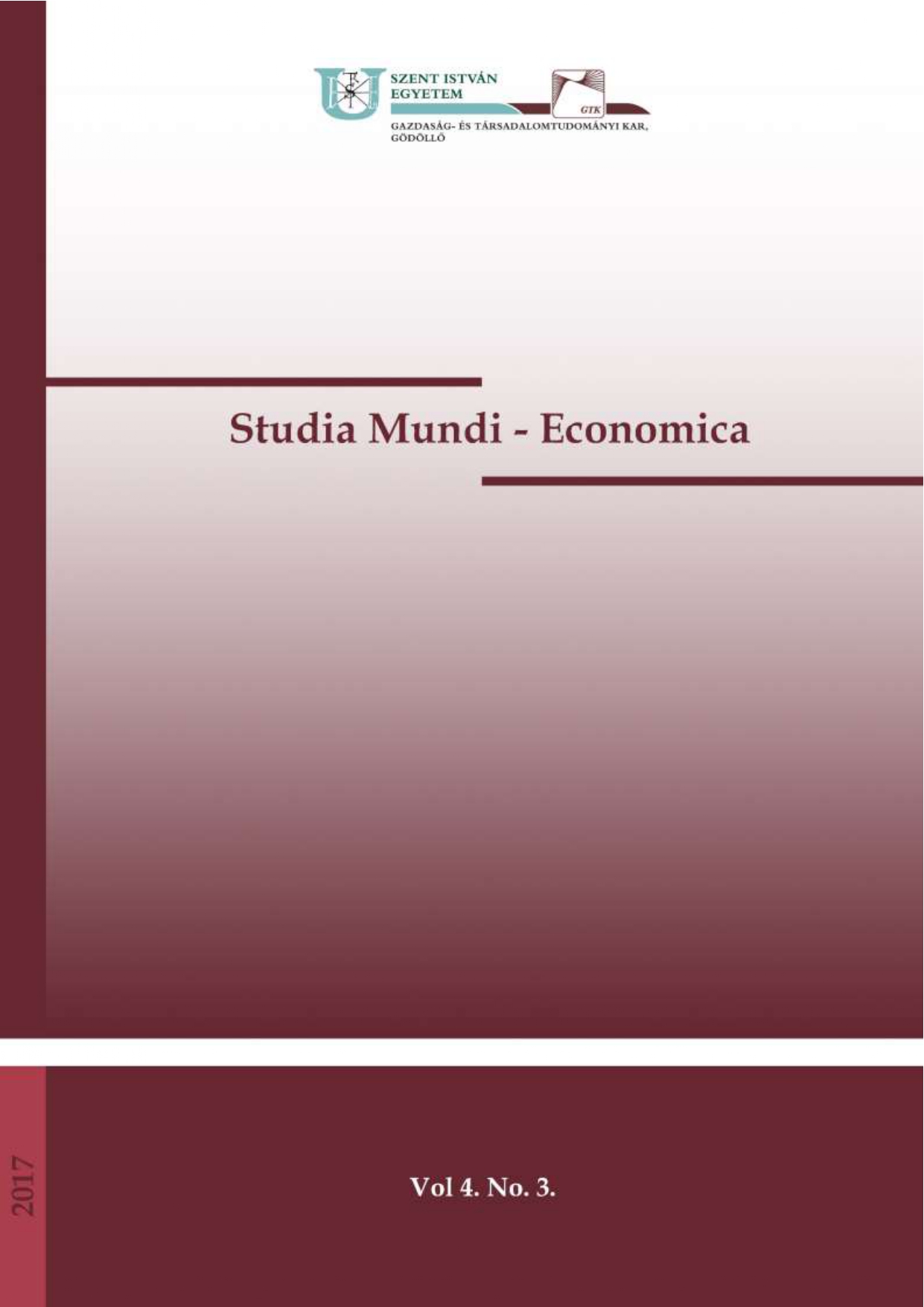Health inequalities on settlement level by the triadic resolution of economic development
DOI:
https://doi.org/10.18531/Studia.Mundi.2017.04.03.32-44Keywords:
egészségegyenlőtlenségek, gazdasági fejlettség, települések, korai halandóságAbstract
The aim of our study is to introduce the health inequalities relating to the economical development at the level of Hungarian settlements. I used the method of the triadic resolution of the economic development to get my goal and in conclusion, with the help of this method I could show that the certain development categories and the health condition are paralel to each other. My results were validated with mathematical-statistical methods (Spearman’s rank correlation, Kruskal Wallis H test) as well.
References
Bálint L. (2010): A területi halandósági különbségek Magyarországon 1980-2006. Budapest, KSH Népességtudományi Kutató Intézet, 119. p. ISBN 978-963-9597-18-1.
Balku E. − Vitrai J. (é.n.): Az OEFI halandósági adatbázisának módszertani ismertetője. http://regi.oefi.hu/halalozas/modszertan.pdf (letöltve: 2016.10.19.)
Barro R. J. (2013): Health and Economic Growth. Annals of Economics and Finance. Vol. 14 No. 2. 305–342. p. ISSN 1529-7373.
Borell C. − Arias A. (1995): Socioeconomic factors and mortality in urban settings: the case of Barcelona, Spain. Journal of Epidemiology and Community Health. Vol. 49 No. 5. 460-465. p. ISSN 1470-2738. DOI: https://doi.org/10.1136/jech.49.5.460.
Cornia G.A. (2016): The mortality crisis in transition economies Social disruption, acute psychosocial stress, and excessive alcohol consumption raise mortality rates during transition to a market economy. The IZA World of Labor project. https://wol.iza.org/articles/mortality-crisis-in-transition-economies/long (letöltve: 2016.12.12.)
Department of Health and Human Services (DHHS) (1980): Inequalities in health: report of a research working group (The Black Report) HMSO, London, 216. p.
Egri Z. (2017): Térségi egészségegyenlőtlenségek az európai makrorégióban (kelet- közép-európai szemszögből). Területi Statisztika. Vol. 57 No. 1. 94-124. p. ISSN 0018- 7828. DOI: https://doi.org/10.15196/TS570105.
European Commission DG Health and Consumer Protection (2005): The contribution of health to the economy in the European Union. Luxembourg , Office for Official Publications of the European Communities, 140. p. ISBN 92-894-9829-3.
Juhász A. et al. (2010): Development of a Deprivation Index and its relation to premature mortality due to diseases of the circulatory system in Hungary, 1998–2004. Social Science & Medicine Vol. 70. 1342-1349. p. ISSN: 0277-9536. DOI: https://doi.org/10.1016/j.socscimed.2010.01.024.
Juhász A. (2010): Térepidemiológia. Lehetőségek és korlátok. Egészségtudomány. Vol. 56 No. 2. 10-20. p. ISSN: 0013-2268.
Kollányi Zs. (2013): A gazdasági fejlődés és az egészségi állapot elméleti összefüggései. Egészségügyi Gazdasági Szemle. Vol. 51. No. 1. 37-44. p. ISSN: 0013- 2276.
Kopp, M.–Réthelyi, J. (2004): Where psychology meets physiology: chronic stress and premature mortality - the Central-Eastern european health paradox. Brain Research Bulletin. Vol. 62. No. 5. 351–367. p. ISSN: 0361-9230. DOI: https://doi.org/10.1016/j.brainresbull.2003.12.001
Központi Statisztikai Hivatal Népességtudományi Kutatóintézet honlapja (2017). http://demografia.hu/hu/tudastar/fogalomtar/60-standardizalt-halalozasi-aranyszam
Nagy Cs. et al. (2011): Mortality amenable to health care and its relation to socio- economic status in Hungary, 2004–08. European Journal of Public Health. Vol. 22. No. 5, 620–624. p. ISSN 1101-1262. DOI: https://doi.org/10.1093/eurpub/ckr143.
Nemes Nagy J. (2004): Új kistérségek, új városok. Új versenyzők? In: Nemes Nagy J. (szerk.): Térségi és települési növekedési pályák Magyarországon: „A régiók és a hazai települések versenyképessége az európai gazdasági térben” c. 5/074/2001 sz. NKFP kutatás keretében készült tanulmányok. Budapest, ELTE Regionális Földrajzi Tanszék
MTA–ELTE Regionális Tudományi Kutatócsoport, 124. p., 5-42. p.
Nemes Nagy, J. (2005): Regionális elemzési módszerek. Regionális Tudományi Tanulmányok 11. Budapest, ELTE Regionális Földrajzi Tanszék-MTA-ELTE Regionális Tudományi Kutatócsoport, 284 p. ISSN: 15851419.
Nemes Nagy, J.–Németh, N. (2003): A „hely” és a „fej”. A regionális tagoltság tényezői az ezredforduló Magyarországán. Budapest, MTA Közgazdaságtudományi Intézet- BKÁE Emberi erőforrások tanszék, 59. p. ISBN 963 9321 90 7.
Németh N. (2008): Fejlődési tengelyek az új hazai térszerkezetben. Az autópálya- hálózat szerepe a regionális tagoltságban. PhD-értekezés. Budapest-Fonyód, ELTE- TTK RTT, 150. p.
Orosz É.–Kollányi Zs. (2016): Egészségi állapot, egészségegyenlőtlenségek nemzetközi összehasonlításban. In: Kolosi, T.–Tóth, I. Gy. (szerk.): Társadalmi Riport. Budapest, TÁRKI, 657 p., 334–357. p., ISSN 1216-6561.
Pénzes J. (2014): Competitiveness of Hungarian towns after the change of regime. Central European Regional Policy and Human Geography. Vol. 4. No. 1. 51-63. p. ISSN 2062-8870.
Preston S. H. (1975, 2007): The changing relation between mortality and level of economic development. Reprinted International Journal of Epidemiology (2007). Vol. 36. No. 3. 484–490. p. ISSN 0300-5771. DOI: https://doi.org/10.1093/ije/dym075.
Sajtos L.–Mitev, A. (2007): SPSS kutatási és adatelemzési kézikönyv. Budapest, Alinea Kiadó, 403. p. ISBN 9789639659087.
Sen, A. (1999): Health in development. Keynote address. Fifty-second World Health Assembly WHO, Genf. http://apps.who.int/gb/archive/pdf_files/WHA52/ewd9.pdf (letöltve: 2013.10.11.)
Soleman H. Abu-Bader (2011): Using Statistical Methods in Social Science Research: With a Complete SPSS Guide. Lyceum Books, Chicago, 375. p.. ISBN-13: 978- 1935871026.
Tóth G. − Nagy Z. (2013): Eltérő vagy azonos pályák? A hazai nagyvárosok és térségek összehasonlító vizsgálata. Területi Statisztika. Vol. 53. No. 6. 593-612. p. ISSN 0018- 7828.
Downloads
Published
Issue
Section
License
Copyright (c) 2017 Egri Zoltán

This work is licensed under a Creative Commons Attribution-NonCommercial-NoDerivatives 4.0 International License.
A folyóirat Open Access (Gold). Cikkeire a Creative Commons 4.0 standard licenc alábbi típusa vonatkozik: CC-BY-NC-ND-4.0. Ennek értelmében a mű szabadon másolható, terjeszthető, bemutatható és előadható, azonban nem használható fel kereskedelmi célokra (NC), továbbá nem módosítható és nem készíthető belőle átdolgozás, származékos mű (ND). A licenc alapján a szerző vagy a jogosult által meghatározott módon fel kell tüntetni a szerző nevét és a szerzői mű címét (BY).






